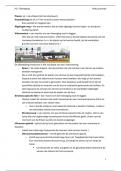Summary
Summary unit 13: Learning aim A acid-base equilibria in order to understand buffer action and to optimise acid-base titration procedures
- Institution
- PEARSON (PEARSON)
My assignment covers all key aspects of acid-base equilibria, including strong and weak acids, alkalis, and buffer solutions. I've explained fundamental concepts such as Brønsted-Lowry theory, acid dissociation constants, and pH calculations. Practical applications in industries like wastewater tr...
[Show more]




